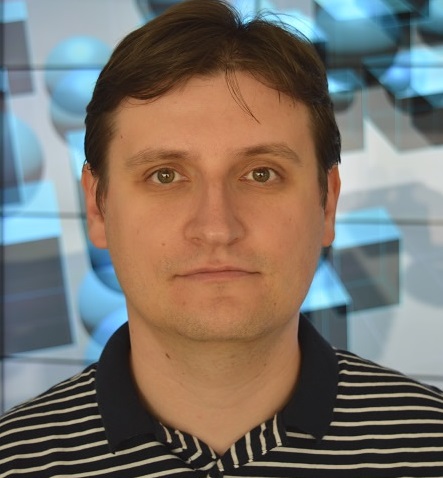
Applied Filters
- Radu-Daniel Vatavu
- AuthorRemove filter
People
Colleagues
- Jean Vanderdonckt (23)
- Laura Bianca Bilius (16)
- Jacob O. Wobbrock (10)
- Ovidiu Ciprian Ungurean (10)
- Cristian Pamparău (9)
- Laurent Grisoni (8)
- Ovidiu Andrei Schipor (8)
- Alexandru Ionuț Şiean (7)
- Bogdan Florin Gheran (7)
- Ştefan Gheorghe Pentiuc (6)
- Adrian Aiordăchioae (6)
- Arthur Sluÿters (6)
- Lisa Anthony (6)
- Luis A. Leiva (5)
- Daniel Martín-Albo (4)
- Irina Popovici (4)
- Santiago Villarreal-Narvaez (4)
- Wenjun Wu (3)
- Yosra Rekik (3)
Publication
Journal/Magazine Names
- Multimedia Tools and Applications (6)
- International Journal of Human-Computer Studies (5)
- Proceedings of the ACM on Human-Computer Interaction (5)
- IEEE Pervasive Computing (2)
- Journal of Ambient Intelligence and Smart Environments (2)
- Virtual Reality (2)
- ACM Computing Surveys (1)
- ACM Transactions on Computer-Human Interaction (1)
- ACM Transactions on Interactive Intelligent Systems (1)
- Information and Software Technology (1)
- Pattern Recognition Letters (1)
- Proceedings of the ACM on Interactive, Mobile, Wearable and Ubiquitous Technologies (1)
Proceedings/Book Names
- CHI EA '24: Extended Abstracts of the CHI Conference on Human Factors in Computing Systems (4)
- IMX '21: Proceedings of the 2021 ACM International Conference on Interactive Media Experiences (4)
- MUM '20: Proceedings of the 19th International Conference on Mobile and Ubiquitous Multimedia (4)
- CHI '23: Proceedings of the 2023 CHI Conference on Human Factors in Computing Systems (3)
- CHI EA '18: Extended Abstracts of the 2018 CHI Conference on Human Factors in Computing Systems (3)
- CHI EA '22: Extended Abstracts of the 2022 CHI Conference on Human Factors in Computing Systems (3)
- CHI EA '23: Extended Abstracts of the 2023 CHI Conference on Human Factors in Computing Systems (3)
- IMX '24: Proceedings of the 2024 ACM International Conference on Interactive Media Experiences (3)
- MUM '21: Proceedings of the 20th International Conference on Mobile and Ubiquitous Multimedia (3)
- CHI '16: Proceedings of the 2016 CHI Conference on Human Factors in Computing Systems (2)
- CHI '17: Proceedings of the 2017 CHI Conference on Human Factors in Computing Systems (2)
- CHI '19: Proceedings of the 2019 CHI Conference on Human Factors in Computing Systems (2)
- EuroITV '13: Proceedings of the 11th European Conference on Interactive TV and Video (2)
- Human-Computer Interaction – INTERACT 2015 (2)
- Human-Computer Interaction – INTERACT 2021 (2)
- ICMI '14: Proceedings of the 16th International Conference on Multimodal Interaction (2)
- MobileHCI '18: Proceedings of the 20th International Conference on Human-Computer Interaction with Mobile Devices and Services (2)
- TVX '14: Proceedings of the ACM International Conference on Interactive Experiences for TV and Online Video (2)
- TVX '15: Proceedings of the ACM International Conference on Interactive Experiences for TV and Online Video (2)
- WMISI '07: Proceedings of the 2007 workshop on Multimodal interfaces in semantic interaction (2)
Publication Date
Export Citations
Publications
Save this search
Please login to be able to save your searches and receive alerts for new content matching your search criteria.
- short-paper
 Published By ACM
Published By ACM Published By ACM
Published By ACMAI as Modality in Human Augmentation: Toward New Forms of Multimodal Interaction with AI-Embodied Modalities
 Radu-Daniel Vatavu
Radu-Daniel VatavuMintViz Lab, MANSiD Research Center, Stefan cel Mare University of Suceava, Romania
ICMI '24: Proceedings of the 26th International Conference on Multimodal Interaction•November 2024, pp 591-595• https://doi.org/10.1145/3678957.3678958AI techniques have always been central to multimodal interaction, being leveraged for sensing user intention, action, and emotion and for generating adaptive feedback. In this process, AI has played the role of enabling technology toward making ...
- 0Citation
- 159
- Downloads
MetricsTotal Citations0Total Downloads159Last 12 Months159Last 6 weeks65
- abstract
 Published By ACM
Published By ACM Published By ACM
Published By ACMBeyond Radar Waves: The First Workshop on Radar-Based Human-Computer Interaction
 Klen Čopič Pucihar
Klen Čopič PuciharFAMNIT, University of Primorska, Slovenia and Department of Information Science, Stellenbosch University, South Africa and Faculty of Information Studies, Slovenia
,Francesca Meneghello
Department of Information Engineering, University of Padova, Italy
,Dariush Salami
Nokia Bell Labs, Finland
, Arthur Sluÿters
Arthur SluÿtersLouvain Research Institute in Management and Organizations, Belgium
, Radu-Daniel Vatavu
Radu-Daniel VatavuMintViz Lab, MANSiD Research Center, ?tefan cel Mare University of Suceava, Romania
EICS '24 Companion: Companion Proceedings of the 16th ACM SIGCHI Symposium on Engineering Interactive Computing Systems•June 2024, pp 97-102• https://doi.org/10.1145/3660515.3662836This workshop targets topics in the emerging area of radar-based interaction while focusing on scientific explorations centred on Engineering Interactive Computer Systems as part of Human-Computer Interaction. Radar technology, traditionally employed ...
- 0Citation
- 73
- Downloads
MetricsTotal Citations0Total Downloads73Last 12 Months73Last 6 weeks13
- short-paper
 Published By ACM
Published By ACM Published By ACM
Published By ACMEngineering Touchscreen Input for 3-Way Displays: Taxonomy, Datasets, and Classification
 Jean Vanderdonckt
Jean VanderdoncktLouvain Research Institute in Management and Organizations, Université catholique de Louvain, Belgium
, Radu-Daniel Vatavu
Radu-Daniel VatavuMintViz Lab, MANSiD Research Center, Stefan cel Mare University of Suceava, Romania
, Arthur Sluÿters
Arthur SluÿtersLouvain Research Institute in Management and Organizations, Université catholique de Louvain, Belgium
EICS '24 Companion: Companion Proceedings of the 16th ACM SIGCHI Symposium on Engineering Interactive Computing Systems•June 2024, pp 57-65• https://doi.org/10.1145/3660515.3661331In the family of personal multi-display devices and environments, 3-way displays conveniently integrate into the conventional form factors of laptops and tablets, featuring both a central display area and two symmetrically expandable lateral sides. ...
- 0Citation
- 45
- Downloads
MetricsTotal Citations0Total Downloads45Last 12 Months45Last 6 weeks6- 1
Supplementary MaterialE3Screen-EICS2024-Appendix.pdf
- wip
 Published By ACM
Published By ACM Published By ACM
Published By ACMExpanding V2X with V2DUIs: Distributed User Interfaces for Media Consumption in the Vehicle-to-Everything Era
 Laura-Bianca Bilius
Laura-Bianca BiliusMintViz Lab, MANSiD Research Center, Stefan cel Mare University of Suceava, Romania
, Radu-Daniel Vatavu
Radu-Daniel VatavuMintViz Lab, MANSiD Research Center, Stefan cel Mare University of Suceava, Romania
, Jean Vanderdonckt
Jean VanderdoncktLouvain School of Management/LiLab, Université catholique de Louvain, Belgium
IMX '24: Proceedings of the 2024 ACM International Conference on Interactive Media Experiences•June 2024, pp 394-401• https://doi.org/10.1145/3639701.3663643Modern in-vehicle infotainment systems connect to drivers’ personal digital devices, such as smartphones, to facilitate calls, notifications delivery, and access to online media and resources while driving. This communications process facilitates ...
- 0Citation
- 54
- Downloads
MetricsTotal Citations0Total Downloads54Last 12 Months54Last 6 weeks3
- demonstration
 Published By ACM
Published By ACM Published By ACM
Published By ACMChairMX: On-Chair Input for Interactive Media Consumption Experiences for Everyone, Everywhere
 Radu-Daniel Vatavu
Radu-Daniel VatavuMintViz Lab, MANSiD Research Center, Stefan cel Mare University of Suceava, Romania
, Laura-Bianca Bilius
Laura-Bianca BiliusMintViz Lab, MANSiD Research Center, Stefan cel Mare University of Suceava, Romania
,Alexandru-Tudor Andrei
MintViz Lab, MANSiD Research Center, Stefan cel Mare University of Suceava, Romania
,Mihail Terenti
MintViz Lab, MANSiD Research Center, Stefan cel Mare University of Suceava, Romania
,Adrian-Vasile Catană
MintViz Lab, MANSiD Research Center, Stefan cel Mare University of Suceava, Romania
,Alexandru-Ionuț Șiean
MintViz Lab, MANSiD Research Center, Stefan cel Mare University of Suceava, Romania
IMX '24: Proceedings of the 2024 ACM International Conference on Interactive Media Experiences•June 2024, pp 447-451• https://doi.org/10.1145/3639701.3661090We introduce ChairMX, on-chair input technology for novel interactive media consumption experiences through the chair. ChairMX is the end result of an elaborate four-stage research and development process involving a systematic literature review of the ...
- 1Citation
- 56
- Downloads
MetricsTotal Citations1Total Downloads56Last 12 Months56Last 6 weeks9
- research-article
 Published By ACM
Published By ACM Published By ACM
Published By ACMThe Age-Reward Perspective: A Systematic Review of Reward Mechanisms in Serious Games for Older People
 Laura-Bianca Bilius
Laura-Bianca BiliusMintViz Lab, MANSiD Research Center, Stefan cel Mare University of Suceava, Romania
,Ovidiu Andrei Schipor
MintViz Lab, MANSiD Research Center, Stefan cel Mare University of Suceava, Romania
, Radu-Daniel Vatavu
Radu-Daniel VatavuMintViz Lab, MANSiD Research Center, Stefan cel Mare University of Suceava, Romania
IMX '24: Proceedings of the 2024 ACM International Conference on Interactive Media Experiences•June 2024, pp 168-181• https://doi.org/10.1145/3639701.3656327We report results from a systematic literature review on the topic of reward systems for older people engaging with serious games, involving an analysis of 121 scientific articles identified from multiple bibliographic databases. Our analysis, employing ...
- 1Citation
- 106
- Downloads
MetricsTotal Citations1Total Downloads106Last 12 Months106Last 6 weeks12
- keynote
 Published By ACM
Published By ACM Published By ACM
Published By ACMEmbracing Non-Natural Design in Human-Computer Interaction
 Radu-Daniel Vatavu
Radu-Daniel VatavuMintViz Lab, MANSiD Research Center, Stefan cel Mare University of Suceava, Romania
AVI '24: Proceedings of the 2024 International Conference on Advanced Visual Interfaces•June 2024, Article No.: 3, pp 1-1• https://doi.org/10.1145/3656650.3660545Decades ago, the natural interaction design paradigm has brought about a revolutionary shift in perspective regarding how interactions with computer systems could and should take place. By promoting intuition, familiarity, and context matching, natural ...
- 0Citation
- 40
- Downloads
MetricsTotal Citations0Total Downloads40Last 12 Months40Last 6 weeks8
- wip
 Published By ACM
Published By ACM Published By ACM
Published By ACMLifelogging in Mixed Reality
Adrian Aiordachioae
MintViz Lab, MANSiD Research Center, Stefan cel Mare University of Suceava, Romania
, Radu-Daniel Vatavu
Radu-Daniel VatavuMintViz Lab, MANSiD Research Center, Stefan cel Mare University of Suceava, Romania
CHI EA '24: Extended Abstracts of the CHI Conference on Human Factors in Computing Systems•May 2024, Article No.: 226, pp 1-8• https://doi.org/10.1145/3613905.3650897Lifelogging is a growing social phenomenon where personal devices capture records of one’s life for future recalling and reminiscing. At the same time, mixed reality worlds are increasingly available due to advances in head-mounted display technology. ...
- 2Citation
- 320
- Downloads
MetricsTotal Citations2Total Downloads320Last 12 Months320Last 6 weeks47- 2
- wip
 Published By ACM
Published By ACM Published By ACM
Published By ACMThe Eclectic User Experience of Combined On-Screen and On-Wrist Vibrotactile Feedback in Touchscreen Input
Mihail Terenti
MintViz Lab, MANSiD Research Center, Stefan cel Mare University of Suceava, Romania
,Matthieu Rupin
hap2U, France
,Baptiste Reynal
hap2U, France
,Laurent Grisoni
University of Lille, France
, Radu-Daniel Vatavu
Radu-Daniel VatavuMintViz Lab, MANSiD Research Center, Stefan cel Mare University of Suceava, Romania
CHI EA '24: Extended Abstracts of the CHI Conference on Human Factors in Computing Systems•May 2024, Article No.: 315, pp 1-7• https://doi.org/10.1145/3613905.3650835On-wrist vibrotactile feedback, such as provided through smartwatches, has been shown to have a positive impact on users’ touch input performance with mobile devices, but the user experience of combined on-screen and on-wrist vibrations has been ...
- 2Citation
- 178
- Downloads
MetricsTotal Citations2Total Downloads178Last 12 Months178Last 6 weeks27- 2
- wip
 Published By ACM
Published By ACM Published By ACM
Published By ACMMight as Well Be on Mars: Insights on the Extraterrestrial Applicability of Interaction Design Frameworks from Earth
 Jean Vanderdonckt
Jean VanderdoncktLouvain Research Institute in Management and Organizations, Université catholique de Louvain, Belgium
, Radu-Daniel Vatavu
Radu-Daniel VatavuMintViz Lab, MANSiD Research Center, Stefan cel Mare University of Suceava, Romania
,Julie Manon
Cliniques Universitaires Saint-Luc, Université catholique de Louvain, Belgium
,Michael Saint-Guillain
Institute for Information and Communication Technologies, Electronics and Applied Mathematics, Université catholique de Louvain, Belgium
,Philippe Lefevre
Institute Of NeuroScience, Université catholique de Louvain, Belgium
,Jessica J. Marquez
NASA Ames Research Center, United States
CHI EA '24: Extended Abstracts of the CHI Conference on Human Factors in Computing Systems•May 2024, Article No.: 239, pp 1-8• https://doi.org/10.1145/3613905.3650807As humanity expands its reach into the Cosmos, the imagination-sparkling prospect of colonizing other planets, such as Mars, becomes increasingly tangible. However, establishing livable environments on Mars necessitates robust and efficient computer ...
- 0Citation
- 194
- Downloads
MetricsTotal Citations0Total Downloads194Last 12 Months194Last 6 weeks33- 2
- wip
 Published By ACM
Published By ACM Published By ACM
Published By ACMWhat Is the User Experience of Eyes-Free Touch Input with Vibrotactile Feedback Decoupled from the Touchscreen?
Mihail Terenti
MintViz Lab, MANSiD Research Center, Stefan cel Mare University of Suceava, Romania
,Maria Casado-Palacios
UVIP Unit, Italian Institute of Technology, Italy and Università di Genova, Italy
,Monica Gori
UVIP Unit, Italian Institute of Technology, Italy
, Radu-Daniel Vatavu
Radu-Daniel VatavuMintViz Lab, MANSiD Research Center, Stefan cel Mare University of Suceava, Romania
CHI EA '24: Extended Abstracts of the CHI Conference on Human Factors in Computing Systems•May 2024, Article No.: 372, pp 1-8• https://doi.org/10.1145/3613905.3650804Vibrotactile cues commonly serve as substitutes for visual feedback in eyes-free touch input, yet not all touchscreens have haptic capabilities. In this work, we examine the user experience of arm-localized vibrations delivered away from the touchscreen ...
- 2Citation
- 197
- Downloads
MetricsTotal Citations2Total Downloads197Last 12 Months197Last 6 weeks40- 2
- research-article
 Published By ACM
Published By ACM Published By ACM
Published By ACMTake a Seat, Make a Gesture: Charting User Preferences for On-Chair and From-Chair Gesture Input
Alexandru-Tudor Andrei
MintViz Lab, MANSiD Research Center, Stefan cel Mare University of Suceava, Romania
, Laura-Bianca Bilius
Laura-Bianca BiliusMintViz Lab, MANSiD Research Center, Stefan cel Mare University of Suceava, Romania
, Radu-Daniel Vatavu
Radu-Daniel VatavuMintViz Lab, MANSiD Research Center, Stefan cel Mare University of Suceava, Romania
CHI '24: Proceedings of the 2024 CHI Conference on Human Factors in Computing Systems•May 2024, Article No.: 555, pp 1-17• https://doi.org/10.1145/3613904.3642028We explore the chair as a referential frame for facilitating hand gesture input to control interactive systems. First, we conduct a Systematic Literature Review on the topic of interactions supported by chairs, and uncover little research on harnessing ...
- 3Citation
- 590
- Downloads
MetricsTotal Citations3Total Downloads590Last 12 Months590Last 6 weeks61- 2
- research-article
The user experience of distal arm-level vibrotactile feedback for interactions with virtual versus physical displays
Mihail Terenti
https://ror.org/035pkj773MintViz Lab, Ştefan cel Mare University of Suceava, 13 Universităţii, 720229, Suceava, Suceava, Romania
,Cristian Pamparău
https://ror.org/035pkj773MintViz Lab, Ştefan cel Mare University of Suceava, 13 Universităţii, 720229, Suceava, Suceava, Romania
, Radu-Daniel Vatavu
Radu-Daniel Vatavuhttps://ror.org/035pkj773MintViz Lab, Ştefan cel Mare University of Suceava, 13 Universităţii, 720229, Suceava, Suceava, Romania
AbstractHaptic feedback, a natural component of our everyday interactions in the physical world, requires careful design in virtual environments. However, feedback location can vary from the fingertip to the finger, hand, and arm due to heterogeneous ...
- 2Citation
MetricsTotal Citations2
- survey
 Published By ACM
Published By ACM Published By ACM
Published By ACMBrave New GES World: A Systematic Literature Review of Gestures and Referents in Gesture Elicitation Studies
 Santiago Villarreal-Narvaez
Santiago Villarreal-NarvaezUniv. of Namur and Université catholique de Louvain, Belgium
, Arthur Sluÿters
Arthur SluÿtersUniversité catholique de Louvain, Belgium
, Jean Vanderdonckt
Jean VanderdoncktUniversité catholique de Louvain, Belgium
, Radu-Daniel Vatavu
Radu-Daniel VatavuŞtefan cel Mare University of Suceava, Romania
ACM Computing Surveys, Volume 56, Issue 5•May 2024, Article No.: 128, pp 1-55 • https://doi.org/10.1145/3636458How do we determine highly effective and intuitive gesture sets for interactive systems tailored to end users’ preferences? A substantial body of knowledge is available on this topic, among which gesture elicitation studies stand out distinctively. In ...
- 8Citation
- 982
- Downloads
MetricsTotal Citations8Total Downloads982Last 12 Months982Last 6 weeks89
- short-paper
 Published By ACM
Published By ACM Published By ACM
Published By ACMFrom Natural to Non-Natural Interaction: Embracing Interaction Design Beyond the Accepted Convention of Natural
 Radu-Daniel Vatavu
Radu-Daniel VatavuMintViz Lab, MANSiD Research Center, Stefan cel Mare University of Suceava, Romania
ICMI '23: Proceedings of the 25th International Conference on Multimodal Interaction•October 2023, pp 684-688• https://doi.org/10.1145/3577190.3616122Natural interactions feel intuitive, familiar, and a good match to the task, user’s abilities, and context. Consequently, a wealth of scientific research has been conducted on natural interaction with computer systems. Contrary to conventional ...
- 6Citation
- 154
- Downloads
MetricsTotal Citations6Total Downloads154Last 12 Months103Last 6 weeks6
- research-article
 Published By ACM
Published By ACM Published By ACM
Published By ACMRadarSense: Accurate Recognition of Mid-air Hand Gestures with Radar Sensing and Few Training Examples
 Arthur Sluÿters
Arthur SluÿtersUniversité catholique de Louvain, LouRIM, Belgium
,Sébastien Lambot
Université catholique de Louvain, Belgium
, Jean Vanderdonckt
Jean VanderdoncktUniversité catholique de Louvain, Belgium
, Radu-Daniel Vatavu
Radu-Daniel VatavuŞtefan cel Mare University of Suceava, Romania
ACM Transactions on Interactive Intelligent Systems, Volume 13, Issue 3•September 2023, Article No.: 16, pp 1-45 • https://doi.org/10.1145/3589645Microwave radars bring many benefits to mid-air gesture sensing due to their large field of view and independence from environmental conditions, such as ambient light and occlusion. However, radar signals are highly dimensional and usually require complex ...
- 5Citation
- 806
- Downloads
MetricsTotal Citations5Total Downloads806Last 12 Months421Last 6 weeks46
- research-article
 Published By ACM
Published By ACM Published By ACM
Published By ACMAccessibility Research in Digital Audiovisual Media: What Has Been Achieved and What Should Be Done Next?
Alexandre Nevsky
Department of Informatics, King's College London, United Kingdom
, Timothy Neate
Timothy NeateDepartment of Informatics, King's College London, United Kingdom
,Elena Simperl
Department of Informatics, King's College London, United Kingdom
, Radu-Daniel Vatavu
Radu-Daniel VatavuMintViz Lab, MANSiD Research Center, Stefan cel Mare University of Suceava, Romania
IMX '23: Proceedings of the 2023 ACM International Conference on Interactive Media Experiences•June 2023, pp 94-114• https://doi.org/10.1145/3573381.3596159The consumption of digital audiovisual media is a mainstay of many people’s lives. However, people with accessibility needs often have issues accessing this content. With a view to addressing this inequality, there exists a wide range of interventions ...
- 4Citation
- 288
- Downloads
MetricsTotal Citations4Total Downloads288Last 12 Months218Last 6 weeks16- 1
Supplementary Materialsupplemental_files.zip
- Article
Effects of Moving Speed and Phone Location on Eyes-Free Gesture Input with Mobile Devices
Milad Jamalzadeh
Lille University, Lille, France
, Yosra Rekik
Yosra RekikUniversité Polytechnique Hauts-de-France, Valenciennes, France
,Laurent Grisoni
Lille University, Lille, France
, Radu-Daniel Vatavu
Radu-Daniel VatavuMintViz Lab, Stefan cel Mare University, Suceava, Romania
,Gualtiero Volpe
University of Genoa, Genoa, Italy
,Alexandru Dancu
MintViz Lab, Stefan cel Mare University, Suceava, Romania
Human-Computer Interaction – INTERACT 2023•August 2023, pp 469-478• https://doi.org/10.1007/978-3-031-42280-5_30AbstractUsing smartphones while moving is challenging and can be dangerous. Eyes-free input gestures can provide a means to use smartphones without the need for visual attention from users. In this study, we investigated the effect of different moving ...
- 2Citation
MetricsTotal Citations2
- research-article
 Published By ACM
Published By ACM Published By ACM
Published By ACMLeveraging Sensorimotor Realities for Assistive Technology Design Bridging Smart Environments and Virtual Worlds
 Radu-Daniel Vatavu
Radu-Daniel VatavuStefan cel Mare University of Suceava, Romania
PETRA '23: Proceedings of the 16th International Conference on PErvasive Technologies Related to Assistive Environments•July 2023, pp 247-253• https://doi.org/10.1145/3594806.3594834Sensorimotor Realities are a newly introduced concept of a computer-based physical-virtual reality with distinctive quality dimensions with respect to virtual, augmented, mixed, and extended reality environments. In this landscape of computer-based ...
- 3Citation
- 78
- Downloads
MetricsTotal Citations3Total Downloads78Last 12 Months49Last 6 weeks1
- wip
 Published By ACM
Published By ACM Published By ACM
Published By ACM“I Could Wear It All of the Time, Just Like My Wedding Ring:” Insights into Older People’s Perceptions of Smart Rings
 Laura-Bianca Bilius
Laura-Bianca BiliusMintViz Lab, MANSiD Research Center, Stefan cel Mare University of Suceava, Romania
, Radu-Daniel Vatavu
Radu-Daniel VatavuMintViz Lab, MANSiD Research Center, Stefan cel Mare University of Suceava, Romania
CHI EA '23: Extended Abstracts of the 2023 CHI Conference on Human Factors in Computing Systems•April 2023, Article No.: 165, pp 1-8• https://doi.org/10.1145/3544549.3585771We present findings from an examination of older adults’ perceptions of and preferences for smart rings, a unique class of interactive wearables gaining traction in the consumer market. To this end, we conducted semi-structured interviews with nine ...
- 2Citation
- 369
- Downloads
MetricsTotal Citations2Total Downloads369Last 12 Months212Last 6 weeks29- 1
Supplementary Material3544549.3585771-talk-video.mp4
Author Profile Pages
- Description: The Author Profile Page initially collects all the professional information known about authors from the publications record as known by the ACM bibliographic database, the Guide. Coverage of ACM publications is comprehensive from the 1950's. Coverage of other publishers generally starts in the mid 1980's. The Author Profile Page supplies a quick snapshot of an author's contribution to the field and some rudimentary measures of influence upon it. Over time, the contents of the Author Profile page may expand at the direction of the community.
Please see the following 2007 Turing Award winners' profiles as examples: - History: Disambiguation of author names is of course required for precise identification of all the works, and only those works, by a unique individual. Of equal importance to ACM, author name normalization is also one critical prerequisite to building accurate citation and download statistics. For the past several years, ACM has worked to normalize author names, expand reference capture, and gather detailed usage statistics, all intended to provide the community with a robust set of publication metrics. The Author Profile Pages reveal the first result of these efforts.
- Normalization: ACM uses normalization algorithms to weigh several types of evidence for merging and splitting names.
These include:- co-authors: if we have two names and cannot disambiguate them based on name alone, then we see if they have a co-author in common. If so, this weighs towards the two names being the same person.
- affiliations: names in common with same affiliation weighs toward the two names being the same person.
- publication title: names in common whose works are published in same journal weighs toward the two names being the same person.
- keywords: names in common whose works address the same subject matter as determined from title and keywords, weigh toward being the same person.
The more conservative the merging algorithms, the more bits of evidence are required before a merge is made, resulting in greater precision but lower recall of works for a given Author Profile. Many bibliographic records have only author initials. Many names lack affiliations. With very common family names, typical in Asia, more liberal algorithms result in mistaken merges.
Automatic normalization of author names is not exact. Hence it is clear that manual intervention based on human knowledge is required to perfect algorithmic results. ACM is meeting this challenge, continuing to work to improve the automated merges by tweaking the weighting of the evidence in light of experience.
- Bibliometrics: In 1926, Alfred Lotka formulated his power law (known as Lotka's Law) describing the frequency of publication by authors in a given field. According to this bibliometric law of scientific productivity, only a very small percentage (~6%) of authors in a field will produce more than 10 articles while the majority (perhaps 60%) will have but a single article published. With ACM's first cut at author name normalization in place, the distribution of our authors with 1, 2, 3..n publications does not match Lotka's Law precisely, but neither is the distribution curve far off. For a definition of ACM's first set of publication statistics, see Bibliometrics
- Future Direction:
The initial release of the Author Edit Screen is open to anyone in the community with an ACM account, but it is limited to personal information. An author's photograph, a Home Page URL, and an email may be added, deleted or edited. Changes are reviewed before they are made available on the live site.
ACM will expand this edit facility to accommodate more types of data and facilitate ease of community participation with appropriate safeguards. In particular, authors or members of the community will be able to indicate works in their profile that do not belong there and merge others that do belong but are currently missing.
A direct search interface for Author Profiles will be built.
An institutional view of works emerging from their faculty and researchers will be provided along with a relevant set of metrics.
It is possible, too, that the Author Profile page may evolve to allow interested authors to upload unpublished professional materials to an area available for search and free educational use, but distinct from the ACM Digital Library proper. It is hard to predict what shape such an area for user-generated content may take, but it carries interesting potential for input from the community.
Bibliometrics
The ACM DL is a comprehensive repository of publications from the entire field of computing.
It is ACM's intention to make the derivation of any publication statistics it generates clear to the user.
- Average citations per article = The total Citation Count divided by the total Publication Count.
- Citation Count = cumulative total number of times all authored works by this author were cited by other works within ACM's bibliographic database. Almost all reference lists in articles published by ACM have been captured. References lists from other publishers are less well-represented in the database. Unresolved references are not included in the Citation Count. The Citation Count is citations TO any type of work, but the references counted are only FROM journal and proceedings articles. Reference lists from books, dissertations, and technical reports have not generally been captured in the database. (Citation Counts for individual works are displayed with the individual record listed on the Author Page.)
- Publication Count = all works of any genre within the universe of ACM's bibliographic database of computing literature of which this person was an author. Works where the person has role as editor, advisor, chair, etc. are listed on the page but are not part of the Publication Count.
- Publication Years = the span from the earliest year of publication on a work by this author to the most recent year of publication of a work by this author captured within the ACM bibliographic database of computing literature (The ACM Guide to Computing Literature, also known as "the Guide".
- Available for download = the total number of works by this author whose full texts may be downloaded from an ACM full-text article server. Downloads from external full-text sources linked to from within the ACM bibliographic space are not counted as 'available for download'.
- Average downloads per article = The total number of cumulative downloads divided by the number of articles (including multimedia objects) available for download from ACM's servers.
- Downloads (cumulative) = The cumulative number of times all works by this author have been downloaded from an ACM full-text article server since the downloads were first counted in May 2003. The counts displayed are updated monthly and are therefore 0-31 days behind the current date. Robotic activity is scrubbed from the download statistics.
- Downloads (12 months) = The cumulative number of times all works by this author have been downloaded from an ACM full-text article server over the last 12-month period for which statistics are available. The counts displayed are usually 1-2 weeks behind the current date. (12-month download counts for individual works are displayed with the individual record.)
- Downloads (6 weeks) = The cumulative number of times all works by this author have been downloaded from an ACM full-text article server over the last 6-week period for which statistics are available. The counts displayed are usually 1-2 weeks behind the current date. (6-week download counts for individual works are displayed with the individual record.)
ACM Author-Izer Service
Summary Description
ACM Author-Izer is a unique service that enables ACM authors to generate and post links on both their homepage and institutional repository for visitors to download the definitive version of their articles from the ACM Digital Library at no charge.
Downloads from these sites are captured in official ACM statistics, improving the accuracy of usage and impact measurements. Consistently linking to definitive version of ACM articles should reduce user confusion over article versioning.
ACM Author-Izer also extends ACM’s reputation as an innovative “Green Path” publisher, making ACM one of the first publishers of scholarly works to offer this model to its authors.
To access ACM Author-Izer, authors need to establish a free ACM web account. Should authors change institutions or sites, they can utilize the new ACM service to disable old links and re-authorize new links for free downloads from a different site.
How ACM Author-Izer Works
Authors may post ACM Author-Izer links in their own bibliographies maintained on their website and their own institution’s repository. The links take visitors to your page directly to the definitive version of individual articles inside the ACM Digital Library to download these articles for free.
The Service can be applied to all the articles you have ever published with ACM.
Depending on your previous activities within the ACM DL, you may need to take up to three steps to use ACM Author-Izer.
For authors who do not have a free ACM Web Account:
- Go to the ACM DL http://dl.acm.org/ and click SIGN UP. Once your account is established, proceed to next step.
For authors who have an ACM web account, but have not edited their ACM Author Profile page:
- Sign in to your ACM web account and go to your Author Profile page. Click "Add personal information" and add photograph, homepage address, etc. Click ADD AUTHOR INFORMATION to submit change. Once you receive email notification that your changes were accepted, you may utilize ACM Author-izer.
For authors who have an account and have already edited their Profile Page:
- Sign in to your ACM web account, go to your Author Profile page in the Digital Library, look for the ACM Author-izer link below each ACM published article, and begin the authorization process. If you have published many ACM articles, you may find a batch Authorization process useful. It is labeled: "Export as: ACM Author-Izer Service"
ACM Author-Izer also provides code snippets for authors to display download and citation statistics for each “authorized” article on their personal pages. Downloads from these pages are captured in official ACM statistics, improving the accuracy of usage and impact measurements. Consistently linking to the definitive version of ACM articles should reduce user confusion over article versioning.
Note: You still retain the right to post your author-prepared preprint versions on your home pages and in your institutional repositories with DOI pointers to the definitive version permanently maintained in the ACM Digital Library. But any download of your preprint versions will not be counted in ACM usage statistics. If you use these AUTHOR-IZER links instead, usage by visitors to your page will be recorded in the ACM Digital Library and displayed on your page.
FAQ
- Q. What is ACM Author-Izer?
A. ACM Author-Izer is a unique, link-based, self-archiving service that enables ACM authors to generate and post links on either their home page or institutional repository for visitors to download the definitive version of their articles for free.
- Q. What articles are eligible for ACM Author-Izer?
- A. ACM Author-Izer can be applied to all the articles authors have ever published with ACM. It is also available to authors who will have articles published in ACM publications in the future.
- Q. Are there any restrictions on authors to use this service?
- A. No. An author does not need to subscribe to the ACM Digital Library nor even be a member of ACM.
- Q. What are the requirements to use this service?
- A. To access ACM Author-Izer, authors need to have a free ACM web account, must have an ACM Author Profile page in the Digital Library, and must take ownership of their Author Profile page.
- Q. What is an ACM Author Profile Page?
- A. The Author Profile Page initially collects all the professional information known about authors from the publications record as known by the ACM Digital Library. The Author Profile Page supplies a quick snapshot of an author's contribution to the field and some rudimentary measures of influence upon it. Over time, the contents of the Author Profile page may expand at the direction of the community. Please visit the ACM Author Profile documentation page for more background information on these pages.
- Q. How do I find my Author Profile page and take ownership?
- A. You will need to take the following steps:
- Create a free ACM Web Account
- Sign-In to the ACM Digital Library
- Find your Author Profile Page by searching the ACM Digital Library for your name
- Find the result you authored (where your author name is a clickable link)
- Click on your name to go to the Author Profile Page
- Click the "Add Personal Information" link on the Author Profile Page
- Wait for ACM review and approval; generally less than 24 hours
- Q. Why does my photo not appear?
- A. Make sure that the image you submit is in .jpg or .gif format and that the file name does not contain special characters
- Q. What if I cannot find the Add Personal Information function on my author page?
- A. The ACM account linked to your profile page is different than the one you are logged into. Please logout and login to the account associated with your Author Profile Page.
- Q. What happens if an author changes the location of his bibliography or moves to a new institution?
- A. Should authors change institutions or sites, they can utilize ACM Author-Izer to disable old links and re-authorize new links for free downloads from a new location.
- Q. What happens if an author provides a URL that redirects to the author’s personal bibliography page?
- A. The service will not provide a free download from the ACM Digital Library. Instead the person who uses that link will simply go to the Citation Page for that article in the ACM Digital Library where the article may be accessed under the usual subscription rules.
However, if the author provides the target page URL, any link that redirects to that target page will enable a free download from the Service.
- Q. What happens if the author’s bibliography lives on a page with several aliases?
- A. Only one alias will work, whichever one is registered as the page containing the author’s bibliography. ACM has no technical solution to this problem at this time.
- Q. Why should authors use ACM Author-Izer?
- A. ACM Author-Izer lets visitors to authors’ personal home pages download articles for no charge from the ACM Digital Library. It allows authors to dynamically display real-time download and citation statistics for each “authorized” article on their personal site.
- Q. Does ACM Author-Izer provide benefits for authors?
- A. Downloads of definitive articles via Author-Izer links on the authors’ personal web page are captured in official ACM statistics to more accurately reflect usage and impact measurements.
Authors who do not use ACM Author-Izer links will not have downloads from their local, personal bibliographies counted. They do, however, retain the existing right to post author-prepared preprint versions on their home pages or institutional repositories with DOI pointers to the definitive version permanently maintained in the ACM Digital Library.
- Q. How does ACM Author-Izer benefit the computing community?
- A. ACM Author-Izer expands the visibility and dissemination of the definitive version of ACM articles. It is based on ACM’s strong belief that the computing community should have the widest possible access to the definitive versions of scholarly literature. By linking authors’ personal bibliography with the ACM Digital Library, user confusion over article versioning should be reduced over time.
In making ACM Author-Izer a free service to both authors and visitors to their websites, ACM is emphasizing its continuing commitment to the interests of its authors and to the computing community in ways that are consistent with its existing subscription-based access model.
- Q. Why can’t I find my most recent publication in my ACM Author Profile Page?
- A. There is a time delay between publication and the process which associates that publication with an Author Profile Page. Right now, that process usually takes 4-8 weeks.
- Q. How does ACM Author-Izer expand ACM’s “Green Path” Access Policies?
- A. ACM Author-Izer extends the rights and permissions that authors retain even after copyright transfer to ACM, which has been among the “greenest” publishers. ACM enables its author community to retain a wide range of rights related to copyright and reuse of materials. They include:
- Posting rights that ensure free access to their work outside the ACM Digital Library and print publications
- Rights to reuse any portion of their work in new works that they may create
- Copyright to artistic images in ACM’s graphics-oriented publications that authors may want to exploit in commercial contexts
- All patent rights, which remain with the original owner
